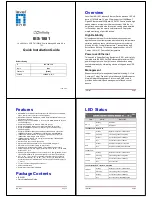
AT-8350GB Installation Guide
41
Dynamic Host
Configuration
Protocol
(DHCP)
This application protocol was developed to simplify network
management. It is used to automatically assign IP configuration
information to the devices on your network, such as an IP address,
subnet mask, and, in some instances, a default gateway address.
The AT-8350GB Fast Ethernet Switch supports this protocol and can
obtain its IP configuration information from a DHCP server on your
network. If you activate this feature, the switch will seek its IP address,
subnet mask, and default gateway from a DHCP server residing on your
network.
Most DHCP services allow you to specify whether the IP address
assignment from the server is to be static or dynamic. If you choose
static, the server will always assign the same IP address to the switch
when the switch is reset or powered on. If you choose dynamic, the
server will assign an unused IP address from its list of potential IP
addresses each time the switch is reset or powered on.
Note
The DHCP option is disabled by default on the switch.
Port Monitoring
The port monitoring feature allows you to unobtrusively monitor the
traffic being received and transmitted on a port on the switch by having
the traffic copied to another switch port. You can connect a network
analyzer to the port functioning as the monitoring port to monitor the
traffic without impacting network performance or speed.
Port Trunking
Port trunking is an economical way for you to increase the bandwidth
between Fast Ethernet switches. A port trunk is two or more data ports
that have been grouped together to increase the bandwidth between
switches by functioning as one logical path. This increase in bandwidth
can prove useful in situations where a single connection between the
devices is insufficient to handle the traffic load.
Port trunks are also useful in adding redundancy to the critical devices of
your network. If one link of a port trunk fails, the remaining links will
continue to provide a connection to the end node.
Despite the software configuration and physical connections, there are
no data loops in a port trunk because of load balancing. The port trunk
always sends packets from a particular source to a particular destination
over the same link within the trunk. A single link is designated for
flooding broadcasts and packets of unknown destination.
Содержание AT-8350GB
Страница 1: ...Fast Ethernet Switch AT 8350GB Installation Guide PN 613 50307 00 Rev B...
Страница 4: ...4...
Страница 82: ...Installation 82...
Страница 88: ...Troubleshooting 88...
















































